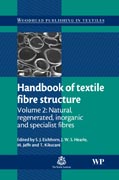
Handbook of textile fibre structure: natural, regenerated, inorganic and specialist fibres 2
Eichhorn, Susan E.
Volume 2 begins by reviewing natural fibres such as cellulosic, cotton, protein, wool and silk fibres. Part two considers regenerated cellulosic, protein, alginate, chitin and chitosan fibres. The final part of the book discusses inorganic fibres such as glass, carbon and ceramic fibres as well as specialist fibres such as thermally and chemically-resistant fibres, optical and hollow fibres. Chapters review how fibre structure contributes to key mechanical properties. A companion volume reviews the structure of manufactured polymer fibres. INDICE: PART 1 NATURAL FIBRES An introduction to cellulosic fibres D Ciechanska, E Wesolowska and D Wawro, Institute of Biopolymers and Chemical Fibres,Poland - Introduction: classification and general characteristic of cellulosic fibres - Organic and inorganic cellulose solvents - Chemical, physical and biochemical modification of cellulose structure - Overview of technologies for spinning cellulosic fibres - Cellulose - based composite fibres - Prospectives-nanocellulosic fibres - References The structure of cotton and other plant fibres M P Ansell, University of Bath, UK and L Y Mwaikambo, University of Dar es Salaam, Tanzania - Introduction - Categorization of plant fibres -The composition and structure of plant fibres - Structure of seed fibres: cotton, kapok and akund - Structure of bast fibre bundles: jute, kenaf, hemp and flax - Structure of leaf fibres: sisal and banana - Structure of fruit fibres: coir and oil palm empty fruit bunch - Conclusions - References An introduction to protein fibres J W S Hearle, University of Manchester, UK - Introduction - Protein structures - The diversity of protein fibres - Conclusion- References The structure and properties of wool and hair fibres F Wortmann,University of Manchester, UK - Introduction - Keratin fibres - Chemical composition - Fibre formation - Morphology - Molecular structures - Mechanical properties and models - Thermal transitions - Conclusions - Sources of further information and advice - References The structure of silk F Vollrath and D Porter, University of Oxford, UK - Introduction - Silk mechanics - Silk composition - Fine structure and morphology - Spider silk: lessons from nature - Silk fibre and its models - Influence of structure on properties - Artificial silks - Conclusions - Acknowledgements - Sources of further information and advice - References PART 2 REGENERATED NATURAL FIBRES The structure of man-made cellulosic fibres J Ganster and H-P Fink, Fraunhofer-Institute for Applied Polymer Research, Germany - Introduction and spinning methods - Structural levels and general models - Rayon (viscose)-type fibres - Lyocell-type fibres - Cellulose acetate based fibres - Future trends - References Regenerated protein fibres: a review M M Brooks, Textile Conservation Centre, UK - Introduction - First and second generation regenerated protein fibres -Surviving examples of first and second generation regenerated protein fibres- Producing first and second generation regenerated protein fibres - Identification of first and second generation regenerated protein fibres - Characteristics of first and second generation regenerated protein fibres - Behaviour of first and second generation regenerated protein fibres - Third generation regenerated protein fibres - Production methods for third generation regenerated protein fibres - Identification of third generation regenerated protein fibres - Fibre properties of third generation regenerated protein fibres - Behaviour of third generation regenerated protein fibres - Summary - Notes - Acknowledgements - References The structure of alginate, chitin and chitosan fibres B Niekraszewicz, Technical University of Lodz and A Niekraszewicz, Institute of Biopolymers and Chemical Fibres, Poland - Introduction - Alginate fibres - Chitin and chitosan fibres - Conclusions - Sources of further information and advice - Acknowledgements - References PART 3 MANUFACTURED NON-POLYMER FIBRES The structure and properties of glass fibres F Jones, University of Sheffield, UK and N T Huff - Introduction - The nature of glass - Fibre manufacture - Strength of glass fibres - Protection of fibres for strength retention - Summary - References The structure of carbon fibres O Paris, Max Planck Institute of Colloids and Interfaces, Germany and University of Leoben,Austria and H Peterlik, University of Vienna, Austria - Introduction - Short historical overview - Types and production of carbon fibres - Fibre structure - Mechanical properties of carbon fibres and their structural origin - Open questions and future directions - Sources of further information and advice - Acknowledgements - References Processing, structure and properties of ceramic fibres G Motz, University of Bayreuth, Germany and R K Bordia, University of Washington, USA - Introduction - Processing, structure and properties of non-oxide fibers - Processing structure and properties of oxide fibers - Comparison of ceramic fibers - Examples of current and anticipated applications - Research and development priorities - Summary and conclusions - Sources of further information and advice - References Structure and properties of asbestos E J W Whittaker, formerly University of Oxford, UK - Introduction -Classification, occurance and physical properties of asbestos - Amphibole asbestos - Chrysotile - Synthetic asbestos - References Thermally and chemically resistant textile fibres: structure and properties J W S Hearle, University of Manchester, England - Introduction - Thermally resistant fibres - Chemically resistant fibres - Conclusion - References Structure, properties and characteristics of optical fibres A Argyros, The University of Sydney, Australia - Waveguide concepts - Fibre structure and optical properties - Types ofoptical fibres, materials and applications - New materials and material combinations in optical fibres - Conclusions - Sources of further information and advice - References Production and applications of hollow fibers M T DeMeuse, Celgard LLC, USA - Introduction - Background - Types of fibers and general features - Polymers used - Structure-property relationships - Conclusions and recommendations - Sources of further information and advice - References
- ISBN: 978-1-84569-730-3
- Editorial: CRC Press
- Encuadernacion: Cartoné
- Páginas: 536
- Fecha Publicación: 30/10/2009
- Nº Volúmenes: 1
- Idioma: Inglés
